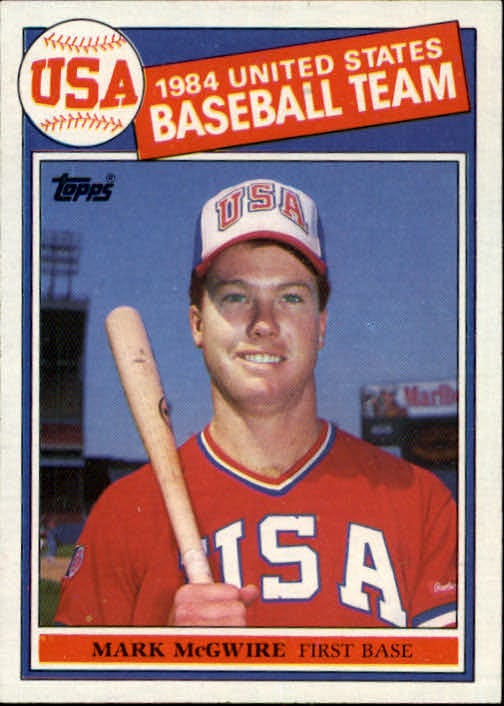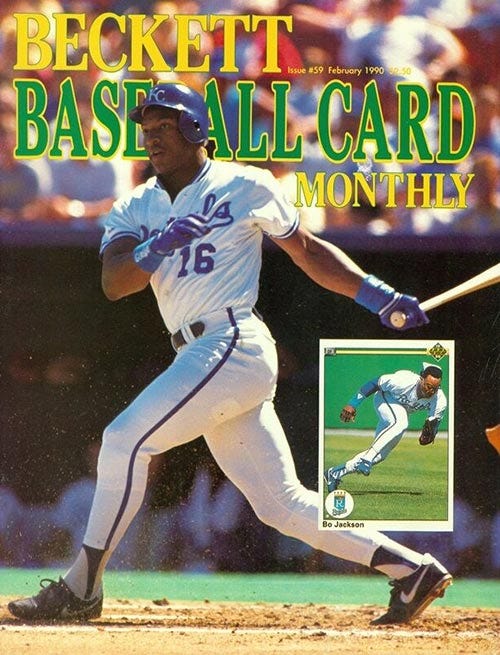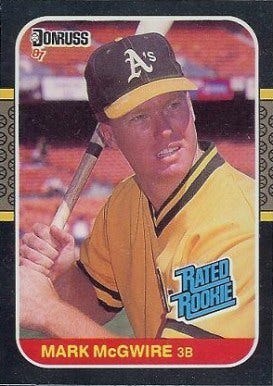
Ten-year-old me walked into the card shop with a plan. Located on the corner of Seventh and Kansas next to a funeral home, the card shop was called My Three Sons. To this day I’m still not completely sure how a small town like the one I grew up in could support a card shop.
Take it as proof that baseball cards were a big deal in the late 80’s/early 90’s. In fact, they were such a big deal that the card companies oversaturated the market, effectively rendering most of the cards we obsessed over completely worthless. No card from that era will likely ever be rare enough to be the next Honus Wagner.
Not that we gave such concerns any thought at the time. Everybody I knew was a collector to some degree or another. Every month, my friends and I bought the latest issue of the Beckett price guide to see if the value of our prized possessions had fluctuated up or down over the last thirty days. Beckett was one of three magazines I regularly purchased as kid, along with Nintendo Power and WWF Magazine. Eventually, all three would be replaced by a subscription to The Sporting News.
All of us had thick three ring binders filled with pages of plastic sleeves stuffed with cards. Some of us put them in without any particular order, and others were more organized. I tended to categorize mine by team, ranking the individual players by either value or personal preference.
Our most valuable cards earned a more protected spot in hard plastic cases. Some were just reinforced plastic sleeves, but the really fancy ones had screws to secure the card in place. Naturally, we honed our GM skills by negotiating a vast array of trades and deals.
And My Three Sons was the hub around which all of this activity revolved. They sold packs and boxes of every card brand within the last couple of years. Valuable individual cards were on display beneath glass. Each of them had a sticker on the upper right hand corner of its case with a hand-written sale price scrawled across it.
Boxes of common cards, usually sold ten at a time for a quarter, lined the walls, along with posters and other memorabilia. They also had novelty cards from time to time. I remember getting several packs of cards promoting Tim Burton’s Batman movie, as well as some WWF Wrestlemania cards.
In other words, the place was awesome. Any time I stayed in town at my grandparents’ house, I would bug one of them to drop me off at the card shop for an hour. The day they finally allowed my cousin and I to walk there by ourselves was a momentous occasion. Not long after, we made a habit of walking there three days a week after swim lessons at the YMCA.
The owner was an overweight, middle-aged guy named Wayne. The smell of smoke wafted around him at all times, which wasn’t surprising since he usually had a cigarette in his mouth. In hindsight, that couldn’t have been good for the cards. The other thing I remember about him was that he was usually cranky.
Wayne also had a shady reputation among us. More than one of my friends claimed to have caught him bending the corners of their cards while inspecting them, then lowballing them with an offer for purchase or trade.
We often wondered why he had ever opened a baseball card shop in the first place, if he didn’t like being around kids and clearly wasn’t overly concerned with the preservation of the cards themselves. There had to be a more enjoyable way for him to make his living, but we were mostly just thankful we had a card shop at all.
And on the day in question, I was sure I was going to get the better of him for a change. The only problem was that I was a dumb kid and my plan was fatally flawed from the start.
I carried in my hand a 1985 Topps Team USA Mark McGwire rookie card. I have no idea how I acquired this card. I didn’t actually start collecting until the following year, but I suspect I inherited in a box of castoffs given to me by an older collector who’d kicked the habit.
Now that I have my own kids, I’ve seen how common this kind of transaction actually is. All a kid has to do is mention an interest in sports and every extended family member, friend of the family, teacher, or whoever else you can imagine in their orbit is more than willing to pass off the cards that have been collecting dust in their basement for years.
The McGwire USA card was not just another common card though. Issued two years before McGwire ever played in the majors as part of a set commemorating the 1984 U.S. Olympic Baseball Team, it is now generally recognized as his first official rookie card.
It’s also one of the few cards of the era that has retained a significant value over the years, though its worth has fluctuated wildly. This is partly due to what is always a volatile market, but mostly a result of McGwire’s own controversial career.
Let me be clear, Mark McGwire was without a doubt my favorite non-Royals player as a kid. As the Royals gradually declined toward the close of the 80’s, I began to throw more and more of my allegiance to the increasingly dominant Oakland Athletics.
The A’s were an extraordinarily talented team that went to three straight World Series from 1988 to 1990, taking home the crown vs. the Giants in the 1989 World Series best remembered for the earthquake that struck the Bay area before Game 3. The team was loaded.
The pitching staff was led by guys like Dave Stewart and Bob Welch, and Dennis Eckersley was making a case for being considered the most dominant closer the game had ever seen up to that point. The lineup featured Tony Philips, Terry Steinbach, Dave Henderson, and Dave Parker. Parker is arguably one of the coolest human beings to ever walk on this planet, but this was toward the tail end of his career and I don’t think I properly appreciated him at the time.
But the focal point was always the Bash Brothers, Jose Canseco and Mark McGwire. Anchoring the lineup in the three and four slots, it is somewhat amusing to me now that the best player on the A’s was always front and center batting leadoff.
Rickey Henderson used to complain about how much money and attention was directed toward sluggers, while he was doing everything else better than them and putting together one of the greatest careers in baseball history. And he had a point. While guys like Canseco and McGwire have seen their legacies tainted by the PED scandal, Rickey’s reputation has only risen higher in the years since his retirement.
I was too young to understand that then, and too easily seduced by the longball. In fact, McGwire made a cameo appearance in a Simpsons episode years later that illustrated how easy it is to be distracted by home runs.
When Springfield discovers that MLB has been spying on them, Big Mac shows up out of nowhere, offering to explain. Then, he adds, “Or who would rather watch me hit some dingers instead?” Everyone excitedly cheers for dingers and the subject is pushed under the rug. Or, more literally, McGwire’s hat. It’s an uncomfortably close analogy to how MLB treated the PED era itself.
Big Mac was a central figure in that era. Playing for the Cardinals in 1998, he and Sammy Sosa raced each other to break Roger Maris’s long held single season home run record of 61. Mac got to 62 first, and eventually ended up setting a new record of 70. Sosa finished with 66.
In my last post, I attempted to downplay the role of the 1998 home run chase in helping baseball bounce back from the 1994 Strike, instead giving some credit to the Braves 1995 World Series championship. But just because I was trying to share some of the love doesn’t mean I don’t recognize the importance of 1998.
No single season or event brought baseball back from the damage inflicted by the Strike on its own, but the impact of the 1998 home run chase can’t be ignored. And I can’t lie. Even knowing what I know today, I have to admit that it was awesome.
I recognize that irreparable damage was inflicted upon one of baseball’s greatest institutions— its record book. Mac, Sosa, and Barry Bonds, who would break McGwire’s record three years later, have to live with those consequences. Their names were dragged through the mud again this past season when Aaron Judge slammed 62 homers (presumably without the assistance of PEDs) and the controversy over who is the real HR King was renewed once again.
But watch the footage of Mac hitting number 62. It’s a fantastic scene. They were playing the Cubs so Sammy Sosa is in attendance and offers his congratulations. Mac hugs his kid and celebrates with both his own family and Roger Maris’s family.
Roger Maris Jr. likes to bad-mouth Mac, Sosa, and Bonds now, frequently proclaiming Judge the real HR champ. I get the hate, and its unfortunate that such hallowed records are now tainted to one degree or another. But that doesn’t change the impact the home run chase had on us all back in 1998.
The effect of PEDs is debatable. They don’t help anyone actually hit a baseball (by far the most challenging aspect of the game), but they definitely help one hit the ball farther. What makes it even more disappointing in relation to these three particular players is that all three were great ballplayers before they ever touched steroids.
Pre-steroid Barry Bonds might have been the most talented all-around player I’ve ever seen. But like Rickey Henderson, he grew jealous of all the attention paid to sluggers like Mac and Sosa. Unlike Rickey, he took the steps to change his body and game to become a slugger himself. He succeeded in this respect and was still a great player, albeit a very different one than earlier in his career.
Mac, on the other hand, was a slugger from the start. He set the AL record for home runs in a season by a rookie in 1987 with 49. He tied for the major league lead with Andre Dawson, who also hit 49 in an NL MVP season for the Cubs.
He’s one of four players to ever hit a HR over the left field roof of old Tiger Stadium, joining the ranks of Harmon Killebrew, Frank Howard, and his contemporary, Cecil Fielder. From 1987-90, he became the first MLB player to hit 30+ HR in each of his first four seasons.
Unfortunately, he got hit with the injury bug shortly after. Many years later in 2010, after initially dodging the question during a congressional inquiry in 2005, he admitted that this was when he first started dabbling with steroids in an attempt to get back on the field.
I’m not making excuses for him. He knew what he did was questionable, even if it technically wasn’t against the rules at the time, and he kept on taking them for years, long after those first injuries had healed. But whether it’s because I loved him as a kid, or because he comes off as so much more likable and contrite than the notoriously disagreeable Bonds, I’m inclined to be more forgiving toward Big Mac.
Don’t get me wrong. I think they should all be in the Hall of Fame, and their PED use should be addressed on their plaques. Their records are what they are, and while I don’t believe in asterisks, I welcome the conversation and debates that surround them.
But on the day that I walked into My Three Sons, those controversies were all still at least a decade away. In that moment, I simply had a number in mind. You see, if I remember correctly, Beckett listed a mint condition McGwire USA card in the neighborhood of $75.
My card was not mint condition. It was a little rougher. But I wanted to get an offer from Wayne to know exactly how much my prized possession was worth in its current condition. I had no intention of selling it to him.
Which was good, because he had no intention of buying. The thing was, I was in total denial over the card’s condition. Sure, it wasn’t mint, but it was passable, I told myself. The corners were a little frayed and the photo was a tad faded. And yeah, maybe it was bent in a couple of spots. So what?
Except the card was actually wrecked. Someone had folded it at least twice prior to my taking ownership of it, leaving several deep creases running across it. The corners were coming apart. The card was a disaster. I just refused to see it.
Wayne had no problem seeing it. And like the dick that he was, he had no problem telling the naïve, delusional kid in front of him that the most important item he owned was completely worthless. In hindsight, that was obvious. But I left the store that day devastated.
Coincidentally, My Three Sons did have a mint condition McGwire USA card under the glass counter. He was charging a hundred bucks for it. And on that day, I made it my mission in life to buy it. I didn’t care how I accomplished the feat. I would mow lawns for years and trade in whatever good cards I accumulated, but in the end I would own that card in its pristine state.
Only I never did. I managed to collect several other McGwire rookie cards, including the 1987 Topps with the wood grain border (one of my favorites) and his Donruss Rated Rookie card where he’s posing in his batting stance wearing the yellow BP jersey. But I never put together the funds for the USA card.
I suppose I saved myself some cash in the long term. The card’s value reached its peak shortly after he broke the HR record in 1998, and then plummeted after the steroid scandal. In the meantime, it’s bounced back a little. A GEM mint condition card (whatever the hell that’s supposed to mean) is currently listed at $750.
A regular mint condition card, which is what I would have been buying, is listed at $45. That would have been a net loss of $55. And yet, part of me thinks it still would have been worth it.
To give you some idea of how much that card meant to me, I hung on to the battered version of it until long after My Three Sons had shuttered its doors. I told myself I was using it as motivation to save up for the mint version, which was true. Just not the whole truth. The fact of the matter was that even in its beat-up condition, I still loved that card.
And I loved My Three Sons. In the years since, various businesses have occupied its former storefront, including a couple of different coffee shops. Currently, it houses the Atchison Art Association, so at least its being used for a noble purpose.
But just the other day I was telling a friend how I’d give just about anything to go back in time and walk into My Three Sons one more time. I don’t have any specific purpose in mind. I just want to browse, taking in the scent of the plastic sleeves and Wayne’s cigarettes as I peruse the treasures under the glass.
Nothing beyond that. I just want to revel a bit in the memories and nostalgia. That would be more than enough.
That said, I’d be mighty tempted to lay down a c-note and walk back to the present with a mint condition Big Mac USA rookie card in my hand.
Ten-year-old me would approve.
Thank you for reading Powder Blue Nostalgia. If you ever obsessed over a specific card or another piece of memorabilia, drop it in the comments below. And please subscribe, if you haven’t already, and recommend PBN to your baseball fan friends.







You have a wonderful blog and a new subscriber. I'd like to invite you to check out my own Oakland A's based blog, "Coco Crisp's Afro."
link: https://cococrispafro.wordpress.com/
I remember when you had that card. We traded it back and forth in the 7th-8th grade. Don’t know why I remember that, but it might have to do with power of the card! Which was in HORRIBLE condition!